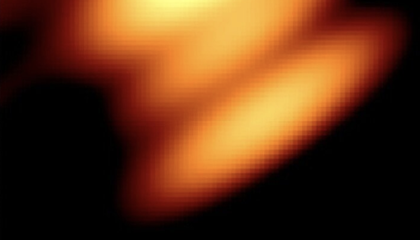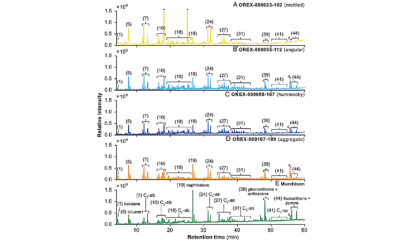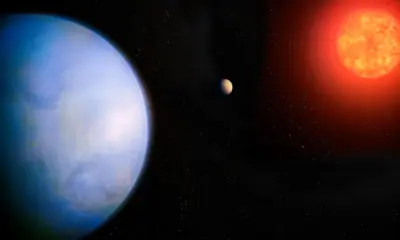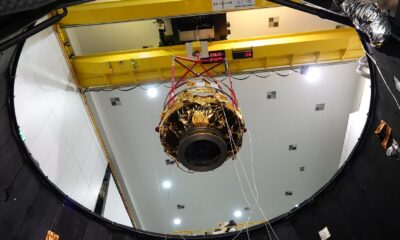Science
Researchers Unveil First Image of Two Orbiting Black Holes

Scientists have captured the first image of two black holes orbiting each other, a groundbreaking achievement that sheds light on a celestial phenomenon studied since the 19th century. This remarkable image, produced by the Event Horizon Telescope (EHT) collaboration, offers new insights into how black holes interact and may help unravel some of the most profound mysteries of the universe.
The study, released in March 2024, focuses on a pair of black holes located in a galaxy approximately 1.3 billion light-years from Earth. Astronomers have long observed this system, known for its bright emissions, yet visual evidence of the black holes’ orbit around each other remained elusive. The EHT, which links eight ground-based radio telescopes around the globe, successfully captured this unprecedented image, marking a significant milestone in astrophysics.
Significance of the Findings
The image not only confirms theoretical predictions about black hole interactions but also enhances our understanding of their formation and evolution. According to researchers from the University of Arizona, the findings provide a visual confirmation of the gravitational effects predicted by Einstein’s theory of general relativity.
Dr. Sheperd Doeleman, a lead scientist with the EHT, expressed excitement about the implications of this discovery. “This image is the culmination of years of hard work and collaboration, and it opens new avenues for understanding the dynamics of black holes,” he stated.
The study’s implications extend beyond mere observation. Insights gained from these black holes could also inform theories related to the origins of galaxies and the distribution of dark matter in the universe. Researchers believe that understanding these cosmic giants can help unlock the secrets of how galaxies evolve over billions of years.
Future Research Directions
The EHT team plans to continue their observations and refine their techniques to capture even clearer images of black holes. Future studies may focus on different black hole systems, providing a broader understanding of their characteristics and behaviors.
These advancements in imaging technology are crucial for deepening our comprehension of fundamental astrophysical processes. As scientists analyze the data from this groundbreaking image, they anticipate uncovering more about the universe’s most enigmatic objects.
The collaboration among global institutions, including universities and research organizations, exemplifies the power of international scientific cooperation. With continued support from organizations such as the National Science Foundation, researchers aim to further explore the mysteries of black holes and their role in the cosmos.
In summary, the visual evidence of two black holes orbiting each other not only enhances our understanding of these fascinating cosmic entities but also paves the way for future discoveries in the field of astrophysics. As the scientific community eagerly anticipates the next revelations, the significance of this achievement will undoubtedly resonate for years to come.
-

 Technology4 months ago
Technology4 months agoDiscover the Top 10 Calorie Counting Apps of 2025
-

 Health2 months ago
Health2 months agoBella Hadid Shares Health Update After Treatment for Lyme Disease
-

 Health3 months ago
Health3 months agoErin Bates Shares Recovery Update Following Sepsis Complications
-

 Technology4 weeks ago
Technology4 weeks agoDiscover 2025’s Top GPUs for Exceptional 4K Gaming Performance
-

 Technology2 months ago
Technology2 months agoElectric Moto Influencer Surronster Arrested in Tijuana
-

 Technology4 months ago
Technology4 months agoDiscover How to Reverse Image Search Using ChatGPT Effortlessly
-

 Technology4 months ago
Technology4 months agoMeta Initiates $60B AI Data Center Expansion, Starting in Ohio
-

 Technology4 months ago
Technology4 months agoRecovering a Suspended TikTok Account: A Step-by-Step Guide
-

 Health4 months ago
Health4 months agoTested: Rab Firewall Mountain Jacket Survives Harsh Conditions
-

 Lifestyle4 months ago
Lifestyle4 months agoBelton Family Reunites After Daughter Survives Hill Country Floods
-

 Technology3 months ago
Technology3 months agoUncovering the Top Five Most Challenging Motorcycles to Ride
-

 Technology4 months ago
Technology4 months agoHarmonic Launches AI Chatbot App to Transform Mathematical Reasoning



















